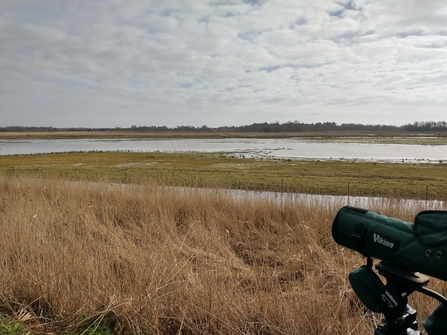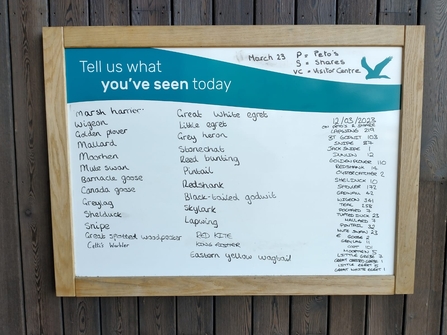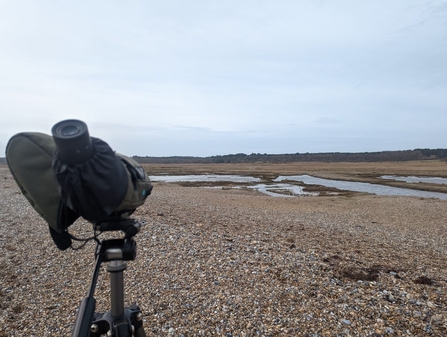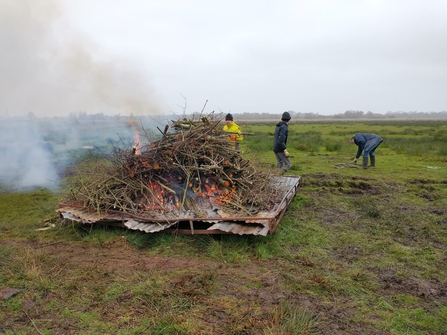Weekly wild news from our reserves – 17th March 2023
Hedge laying at Foxburrow, Ella Broom
The woodland team and their brilliant volunteers have been busy creating dead hedges to protect the newly cut coppice coupe from grazing deer. It helps when the weather is kind!
Also, we have welcomed our local green wood workers to the wood. They have bought some of the main logs from trees felled in last year’s block. The trees were felled to allow more light to the woodland floor as part of our continual coppicing management. In the photos you can see them milling the logs into beams for a green oak workshop they are going to build for themselves.
Producing sustainable woodland products such as stakes and poles at Bradfield Woods has been happening for centuries. If you’d like to find out more, click here.

Woodland products at Bradfield Woods, Alex Lack
Hedge-laying at Foxburrow
It’s important that work on hedges is completed before the bird nesting season begins and the team at Foxburrow managed to complete a lovely laid hedge with the help of Glyn Burchill, a volunteer at Martin's Meadow, and skilled hedge-layer. Glyn has been teaching both Jessica and Ella the craft of hedge-laying, and we think the results look great.
Winter Wetland Birds Survey
Our teams have been taking part in Wetland Bird Survey (WeBs) counts over the winter. The Wetland Bird Survey is the monitoring scheme for non-breeding waterbirds in the UK. This scheme provides the principal data for the conservation of their populations and wetland habitats and is run by the British Trust for Ornithology (BTO).

Winter WeBs count at Carlton Marshes, Lewis Yates

Sightings board at Carlton Marshes, Lewis Yates
This week was the last count of the year at Carlton Marshes. Warden Lewis Yates reports: “Peto’s Marsh was chock full today, including the eastern yellow wagtail that continues to attract visitors. There were good numbers of teal and snipe particularly, and the whole of Carlton Marshes is full of birds at the moment which is really great to see.”
Jamie Smith was counting at Dingle Marshes too. Jamie reports: “The highlights were whooper swan, white-fronted goose and spotted redshank, as well as good numbers of snipe.”

WeBs count at Dingle Marshes, Jamie Smith
The UK is incredibly important for waterbirds. Britain is situated on some of the major flyways for Arctic-nesting species and large numbers of waterbirds are attracted here, especially during winter, by our relatively mild climate and areas of wetland, notably estuaries. It is very important that wetland habitats are protected and species monitored to enable effective conservation measures to be put in place.
Skylark territory counting at Knettishall
We were also counting skylark territories at Knettishall Heath this week too. Reserves Intern Anneke Emery was up very early, along with other members of the team, and settled into a cold, foggy morning listening to the birds and, when the fog cleared, sighting them!
A red-listed farmland bird, skylark populations are tragically in steep decline.
Male skylarks can be spotted rising almost vertically from open farmland, grassland and heathland. They sing from a great height and their long and complicated song-flights can last for up to an hour. Despite their aerial activities, skylarks nest on the ground, laying three to four eggs. It is important that dogs are kept on a lead to avoid disturbance.
Skylark at Knettishall Heath, Anneke Emery (https://youtu.be/LGjCXaOqJuw)
Skylark at Knettishall Heath, Anneke Emery
Skylark singing at Knettishall Heath, Anneke Emery (https://youtu.be/OYRZD3t-coA)
Skylark singing at Knettishall Heath, Anneke Emery
Martlesham Wilds
We had a dusting of snow, and of course, the weather doesn’t stop most of our planned activities. Charlie Zakss welcomed a group of University of Suffolk Ecology students to Martlesham Wilds on a very cold day. The students were excited by the wilding vision for the site, and we hope to work with them in the future to help with monitoring as the wildlife adapts to the change in land use here.
If you haven’t visited Martlesham Wilds as yet and would like to find out more about this new nature reserve for Suffolk, you can join our webinar on April 5th. Find out more here.
Sluices, dykes and fences
Warden Jamie Smith has been installing a new sluice and associated fencing at Hen Reedbeds. This was all installed during a period of high winds, which made things a little tricky!
It’s a good time of year to slub out the dykes and carry out routine maintenance before spring really starts to get going. Our contractors have been busy clearing the dykes at Darsham Marshes. It may look brutal, but it helps keep the water healthy for wildlife as we move into spring and summer.
Matt Gooch, our North East Suffolk Sites Manager, is constantly looking at how wet Carlton Marshes is, and can control water levels on the marshes through much of the year with our network of dykes and sluices. In early spring, Matt is looking to expose muddy, roughed up edges on the islands within the reedbed and ensuring that there is enough dry ground for breeding waders on the scrapes. Matt comments: “It is always a fine balance between ensuring enough water is retained to sustain the muddy edges for birds feeding chicks in early summer, but also lowering the risk of nest sites being flooded out should we have a period of heavy rain. The team work hard to monitor this and try to get it right.”
Sluice at Carlton Marshes, Matt Gooch (https://youtu.be/lCqTtxMgLI4)
Sluice at Carlton Marshes, Matt Gooch
Castle Marshes
Warden Lewis Yates and the volunteer teams have finished the winter season of scrub control with a burn-up at Castle Marshes. They were being watched by a great white egret on the adjacent marsh for most of the morning!
We try to avoid burning woody material on our reserves where we can. It’s either used as dead hedging material, chipped and removed, or piled into habitat piles to slowly rot down - brilliant for invertebrates and other wildlife. Occasionally, when we need to remove woody debris on site (such as in some of our sensitive meadow sites) and / or where willow (when cut) is likely to re-root if left in situ, we use a fire sled, which keeps the fire from damaging the ground and we can dispose of the ash off site without causing nutrient enrichment. We also will burn if access is a problem and if we can’t get heavy machinery on to the site without damaging and compacting the ground.

Fire sled at Caste Marshes, Lewis Yates


































